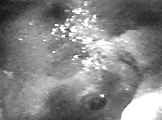What are seeps ?
Seeps are continuous emissions of gases and/or liquids from terrestrial or marine sources. Types of seeps include diffuse seepage of fluids over large areas of the mid-ocean ridges, terrestrial springs and tar pits, terrestrial gas seeps (such as the Chimera in Greece), marine carbonate seeps on the continental shelves and marine gaseous and liquid hydrocarbon seeps.
The research at UC Santa Barbara focuses on an 18 square kilometer region of intense gas and liquid (natural gas and crude oil) hydrocarbon emissions. These seeps are located offshore of Coal Oil Point, California in the Santa Barbara Channel and are perhaps the largest known marine hydrocarbon seeps in the world.
The gas and oil originates from a petroleum reservoir 1500 meters below the sea floor. They seep from the crests of anticlines exposed on the seafloor through as much as 60 meters of water to the surface. On the sea surface, locations of seeps are characterized by patches of bubbles and oil slicks that extend down-current.

